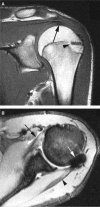Massive rotator cuff tear in an adolescent athlete: a case report
- PMID: 23015923
- PMCID: PMC3438862
- DOI: 10.1177/1941738109350404
Massive rotator cuff tear in an adolescent athlete: a case report
Abstract
Full-thickness rotator cuff tears in the young athlete are a rare injury. These injuries typically result from an acute traumatic event in a contact athlete, as opposed to overuse injuries more commonly seen in throwing athletes. Acute tears may be initially overlooked, with the symptoms attributed to other, more common causes, such as cuff contusion or brachial plexus neuropraxia ("stinger" or "burner"). If undiagnosed, the tear may progress to an irreparable state at the time of eventual diagnosis. Therefore, rotator cuff tear must be included in the differential for acute shoulder injuries in the young athlete. This article presents a case of an adolescent athlete with a traumatic, massive rotator cuff tear that was diagnosed and managed promptly with excellent outcome.
Keywords: adolescent; athlete; rotator cuff tear.
Conflict of interest statement
No potential conflict of interest declared.
Figures




References
-
- Andrews JR, Broussard TS, Carson WG. Arthroscopy of the shoulder in the management of partial tears of the rotator cuff: a preliminary report. Arthroscopy. 1985;1:117-122 - PubMed
-
- Bach HG, Goldberg BA. Posterior capsular contracture of the shoulder. J Am Acad Orthop Surg. 2006;14:265-277 - PubMed
-
- Blevins FT. Rotator cuff pathology in athletes. Sports Med. 1997;24:205-220 - PubMed
-
- Blevins FT, Hayes WM, Warren RF. Rotator cuff injury in contact athletes. Am J Sports Med. 1996;24:263-267 - PubMed
-
- Burkhart SS. Internal impingement of the shoulder. Instr Course Lect. 206;55:29-34 - PubMed
LinkOut - more resources
Full Text Sources

